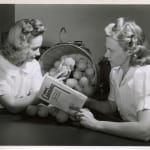Various Photographers
Large Group of Photos Demonstrating Home-Canning as Part of the "Victory Gardens" War Effort, 1942-44
Silver prints (29)
Each 8 x 10 inches
With typed captions and photographer's credit stamp verso.
With an accompanying typed summary.
With typed captions and photographer's credit stamp verso.
With an accompanying typed summary.
Further images
-
(View a larger image of thumbnail 1
)

-
(View a larger image of thumbnail 2
)

-
(View a larger image of thumbnail 3
)

-
(View a larger image of thumbnail 4
)

-
(View a larger image of thumbnail 5
)

-
(View a larger image of thumbnail 6
)

-
(View a larger image of thumbnail 7
)

-
(View a larger image of thumbnail 8
)

A tidy and fascinating collection of photos demonstrating home-canning, as part of the Victory Gardens war effort during WW2. From the National Parks Service: Like planting Victory Gardens, preserving the...
A tidy and fascinating collection of photos demonstrating home-canning, as part of the Victory Gardens war effort during WW2.
From the National Parks Service:
Like planting Victory Gardens, preserving the harvest was also presented as patriotic. Extensive resources were available from the government, local agricultural extension services, and businesses. Preservation could take several forms: drying (dehydrating), freezing, pickling, and canning. Each of these approaches had pros and cons, and were not equally suitable for all products. For example, sources recommended drying corn because it retained good flavor and was a challenge to can. Sources also discouraged canning lettuce (gross) and canning vegetable mixes (too dangerous).
The present photographs were mainly taking in the D.C. suburbs and showcase methods for canning peaches, beans, and other produce. The photos are credited to Mead and Knell and included is a typed summary of the program.
From the National Parks Service:
Like planting Victory Gardens, preserving the harvest was also presented as patriotic. Extensive resources were available from the government, local agricultural extension services, and businesses. Preservation could take several forms: drying (dehydrating), freezing, pickling, and canning. Each of these approaches had pros and cons, and were not equally suitable for all products. For example, sources recommended drying corn because it retained good flavor and was a challenge to can. Sources also discouraged canning lettuce (gross) and canning vegetable mixes (too dangerous).
The present photographs were mainly taking in the D.C. suburbs and showcase methods for canning peaches, beans, and other produce. The photos are credited to Mead and Knell and included is a typed summary of the program.







